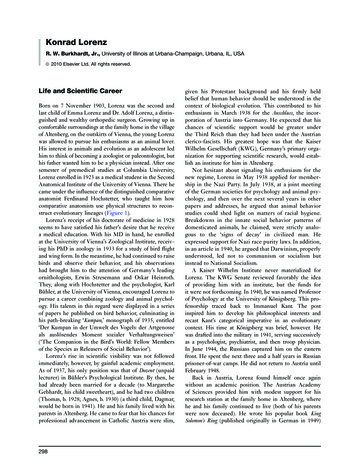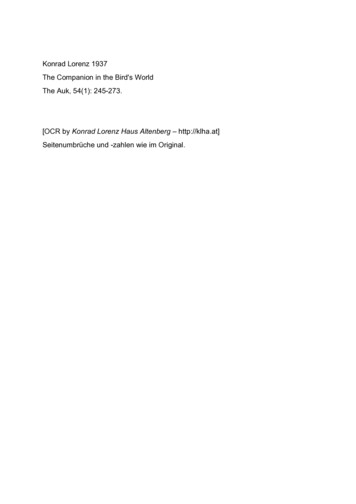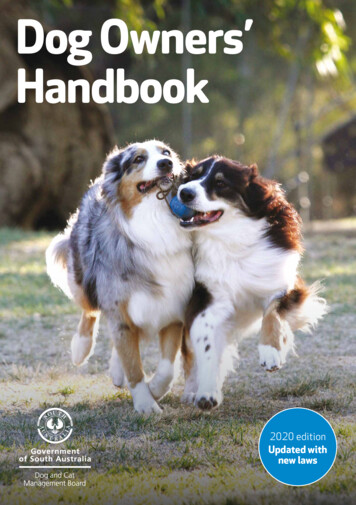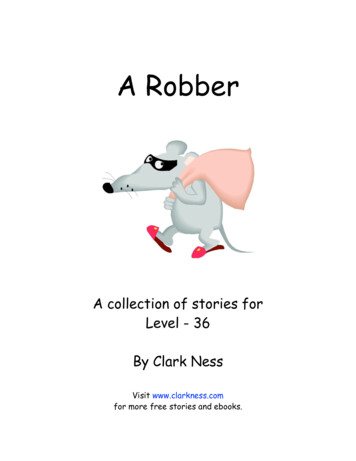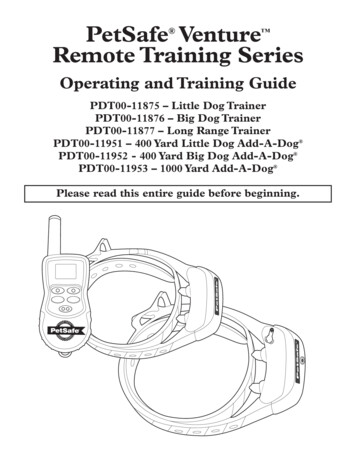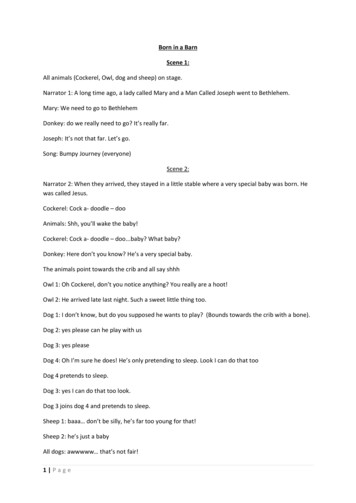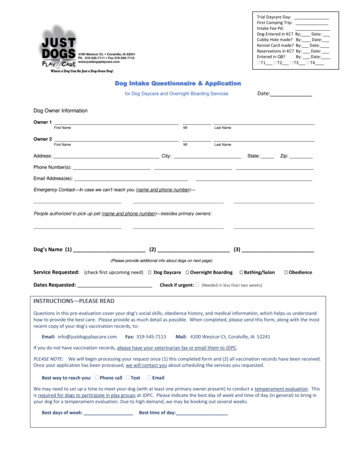
Transcription
Man Meets Dog‘Konrad Lorenz’s ideas have a wide sweep and his enthusiasm is boundless.’The Times Literary Supplement‘Few men have contributed more to the modern study of animal behaviourthan Dr Konrad Lorenz.’G. S. Carsdale
KonradLorenzMan Meets DogTranslated by Marjorie Kerr WilsonIllustrated by Annie Eisenmenger and the author
So Kam der Mensch auf den Hund first published 1949by Verlag Dr. Borotha Schoeler, ViennaEnglish edition first published 1954by Methuen & Co. LtdFirst published in Routledge Classics 2002by Routledge11 New Fetter Lane, London EC4P 4EE29 West 35th Street, New York, NY 10001Routledge is an imprint of the Taylor & Francis GroupThis edition published in the Taylor & Francis e-Library, 2005.“To purchase your own copy of this or any of Taylor & Francis or Routledge’scollection of thousands of eBooks please go to www.eBookstore.tandf.co.uk.” 1983 Deutscher Taschenbuch Verlag GmbH & Co. KG, Munich,GermanyTranslation 1999 Deutscher Taschenbuch Verlag GmbH & Co. KG,Munich, GermanyThis edition 2002 RoutledgeAll rights reserved. No part of this book may be reprintedor reproduced or utilised in any form or by any electronic,mechanical, or other means, now known or hereafterinvented, including photocopying and recording, or inany information storage or retrieval system, withoutpermission in writing from the publishers.British Library Cataloguing in Publication DataA catalogue record for this book is available from the British LibraryLibrary of Congress Cataloging in Publication DataA catalog record for this book has been requestedISBN 0-203-16608-6 Master e-book ISBNISBN 0-203-26069-4 (Adobe eReader Format)ISBN 0–415–26745–5 (pbk)ISBN 0–415–26744–7 (hbk)
CONTENTSINTRODUCTION: MAN AND THE DOMESTIC ANIMALS1. How it may have Started2. Two Origins of Fidelity3. Canine Personalities4. Training5. Canine Customs6. Master and Dog7. Dogs and Children8. Choosing a Dog9. An Appeal to Dog Breeders10. The Truce11. The Fence12. Much ADO about a Little Dingo13. What a Pity He can’t Speak—He Understands every Word14. Affection’s Claim15. Dog Days16. On Feline Play17. Man and the Cat18. Animals that Lie19. ‘Cat!’20. The Animal with a Conscience21. Fidelity and DeathINDEX
INTRODUCTIONMan and the domestic animalsOr by necessity constrained, they liveDependent upon Man; those in his fields,These at his crib, and some beneath his roof.They prove too often at how dear a rateHe sells protection.Cowper: The Winter Walk at NoonTo-day for breakfast I ate some fried bread and sausage. Both the sausage and the lardthat the bread was fried in came from a pig that I used to know as a dear li le piglet.Once that stage was over to save my conscience from conflict, I meticulously avoidedany further acquaintance with that pig. I should probably only eat animals up to themental level of fish or, at the most, frogs, if I were obliged to kill them myself. It is, ofcourse, hypocritical to avoid, in this way, the moral responsibility for the murder. But,in any case, the a itude of a human being to the animals whi he rears for food is asomewhat contradictory one. In the case of farmers, who follow a certain age-oldtradition, the relation of man to beast is determined by a line of conduct of an almostritual kind whi becomes so mu a ma er of course as to relieve him of any moralresponsibility or feeling compunction. But for the man who is engaged professionallyin resear into the animal mind whi , in its inmost workings, so mu resembles ourown, the ma er assumes an entirely different aspect. For him, the slaughtering of afarm animal is something infinitely worse than the shooting of game. e hunter doesnot know the la er personally or, at least, not so intimately as the farmer does thedomestic animal and, above all, the game animal recognizes the danger it is in. Morallyit is mu worse to wring the ne of a tame goose whi approa es one confidentlyto take food from one’s hand than it is, at the expense of some physical effort and agreat deal of patience, to shoot a wild goose whi is fully conscious of its danger and,moreover, has a good ance of eluding it. Almost more questionable than therelations of man to the animals whi he honestly consumes and whi , up to the timeof their unexpected and usually qui death, lead an easy and comfortable life, is hisa itude towards those whi he uses for other purposes. e fate of the horse, whi ,with advancing years, leads an ever more tragic existence, is too pitiable to dwell upon.And the coldbloodedness with whi calves are slaughtered, and even the cow herselfwhen, milked to the last drop, she can no longer ‘pay her way’, is one of the less
pleasant aspects of the association between man and the domestic animals.It is only from a very wide biological viewpoint whi considers not the individualbut the species as a whole, that the connection between man and animals can belooked upon as a mutual advantage, a ‘symbiosis’. One might say that the species,Horse, Cow, Sheep etc. might in some measure welcome their domestication sincetheir wild progenitors, unable to exist in civilized countries, became extinct long ago.Another feature whi exculpates man to some extent is the fact that he is boundby no agreement, by no contract with the animals in question, to treat them asanything but enemies whi he has taken prisoner. Even highly civilized peoples in theeras before Christ were accustomed to treat their prisoners no be er than domesticanimals. e North American Indians used to martyr them and the Papuans eat themeven to-day with excellent appetite and with mu less moral compunction than I feltthis morning on eating that sausage.Only two animals have entered the human household otherwise than as prisonersand become domesticated by other means than those of enforced servitude: the dogand the cat. Two things they have in common, namely, that both belong to the order ofcarnivores and both serve man in their capacity of hunters. In all other aracteristics,above all, in the manner of their association with man, they are as different as the nightfrom the day. ere is no domestic animal whi has so radically altered its whole wayof living, indeed its whole sphere of interests, that has become domestic in so true asense as the dog: and there is no animal that, in the course of its centuries-oldassociation with man, has altered so little as the cat. There is some truth in the assertionthat the cat, with the exception of a few luxury breeds, su as Angoras, Persians andSiamese, is no domestic animal but a completely wild being. Maintaining its fullindependence it has taken up its abode in the houses and outhouses of man, for thesimple reason that there are more mice there than elsewhere. e whole arm of thedog lies in the depth of the friendship and the strength of the spiritual ties with whi he has bound himself to man, but the appeal of the cat lies in the very fact that she hasformed no close bond with him, that she has the uncompromising independence of atiger or a leopard while she is hunting in his stables and barns; that she still remainsmysterious and remote when she is rubbing herself gently against the legs of hermistress or purring contentedly in front of the fire. e purring cat is, for me, a symbolof the hearthside and the hidden security whi it stands for. I should no more like tobe without a cat in my home than to be without the dog that trots behind me in fieldor street. Since my earliest youth I have always had dogs and cats about me, and it isabout them that I shall talk in this book. Business-like friends have advised me to writea dog-book and a cat-book separately, because dog-lovers o en dislike cats and catlovers frequently abhor dogs. But I consider it the finest test of genuine love andunderstanding of animals if a person has sympathies for both these creatures, and canappreciate in each its own special virtues.
To all those who love and understand dogs and cats alike I dedicate this little book.
1
HOW IT MAY HAVE STARTEDSome show that nice sagacity of smell,And read with such discernment in the portAnd figure of the man, his secret aimThat oft we owe our safety to a skillWe could not teach and must despair to learn.Cowper rough the tall grass of the plain a li le group of people makes its way, an unclothed,uncivilized band. ey are certainly human beings like ourselves, their build nodifferent from that of present-day man. In their hands they carry bone-tipped spears,some even have bows and arrows, but in their behaviour there is something whi would be foreign even to present-day savages of the lowest cultural type, and whi would strike a modern observer as being an animal trait. ese men are no lords ofcreation that look fearlessly out into the world; instead, their dark eyes move to andfro restlessly as they turn their heads, glancing from time to time fearfully over theirshoulders. ey remind one of deer, hunted animals that must always be watchful. ey give wide berth to bushes and the taller vegetation of the steppes whi mayeasily shelter a large beast of prey, and, as on one occasion, a big antelope breaks coverwith a loud rustling, they start nervously, hastily adjusting their spears for action. enext moment, recognizing the harmlessness of the animal, their fear gives place torelieved but excited a er and finally to hilarious laughter. But this eerful moodsoon subsides: the band is downcast and with good reason. In the course of the lastmonth, they have been forced by stronger, more populous tribes, to relinquish theiroriginal hunting grounds for the plains of the West, a country whi they do not knowand where large beasts of prey are mu more prevalent than in the abandonedterritory. e knowing old hunter who was their leader lost his life a few weeks ago;he was wounded by a sabre-toothed tiger whi tried one night to steal a young girlfrom the band. In a fever of excitement, all the men set their spears at the tiger, theleader at their head, but unlu ily it was he that received the brunt of its a a . egirl was already dead and the leader died of his wounds the next day. e fact that thetiger also died a week later of peritonitis caused by a spear wound in his abdomen wasof small direct advantage to the li le band of people. is now consisted of but fivegrown men, the rest being women and ildren, and five men are not enough to beatoff the a a s of a large beast of prey. Nor is the man who has assumed the leadershipso endowed with experience and muscle-power as was the former leader. But his eyesare brighter and his forehead higher and more ar ed than that of the other. edepleted group suffers most from la of sleep. In their own territory they used to
sleep round the fire and, moreover, they possessed a guard of whi , till now, theywere unaware. e ja als that followed in the tra s of the human hordes, scavengingthe refuse from slaughtered animals, surrounded their camp at night in a close circle.No feelings of friendship united the humans with their troublesome followers. Missilesgreeted every ja al that dared approa too near the fire, and occasionally an arrowwas aimed at them, though it was seldom that one was wasted on su unappetizingcreatures.Even to-day, in the eyes of many peoples, the dog is still marked out as an uncleananimal in consequence of his disreputable ancestors. Nevertheless, the ja als were adefinite help to the human beings whose footsteps they followed: to some extent, theysaved them the trouble of se ing a wat , since the clamour they set up on theapproach of a beast of prey announced from afar the appearance of the marauder. ese primitive human beings, careless and unthinking, were unaware of thisusefulness of their four-legged retinue; but now that it was missing, the uncannystillness around the camp was so sinister that even those who were not entrusted withthe wat hardly dared to close an eye; and this proved most exhausting, since theirvigilance was already overtaxed owing to the small number of able-bodied men thattheir band included. And so the li le company, tired and nervous and thoroughlydisconsolate, pursued its way, jumping at every sound and seizing its weapons, andnow very seldom bursting into guffaws when the alarm proved to be a false one. Atthe approa of evening, the dread of the coming night began to weigh heavy onevery mind; they were obsessed by that fear of the unknown whi , engraved inbygone eras into the convolutions of our brain, renders even to-day the darkness ofnight a source of terror to the ild and, to the adult, the symbol of all things evil. isis an age-old memory of the time when the powers of darkness, in the form of flesheating beasts of prey, sprang out of the night upon human beings. For our forefathersthe night must indeed have held unlimited terrors. e silent group of people presses closer together and begins sear ing for a placefar from any bushy cover, where they will be safe from the a a of predatory beasts.Here, by a slow and tiresome procedure, they will light their camp fire and roast anddivide the meagre spoils of the day. e repast consists to-day of the already ‘high’remains of a wild boar, the leavings from the meal of the sabre-toothed tiger, fromwhi the men had driven off, a er a struggle, a pa of hyena dogs. Su a mutilatedcarcase would hardly seem appetizing to us but the members of the band cast hungrylooks at their leader who is carrying the half-eaten skeleton himself in order to saveany less responsible person from temptation. Suddenly the footsteps of the band halt asif at an order. All heads are turned in the direction whence they have come and, like aherd of startled deer, they all focus their senses in that one direction. They have heard asound, the call of an animal whi , strangely enough, brings no threat with it as mostanimal calls do: for only the hunting animal gives tongue—the hunted have long ago
learned to be silent. But this sound seems to the wanderers like a message from home,a reminder of happier and less dangerous times, for it is the howl of a ja al. It almostseems as though the band, in its ild-like, almost ape-like impulsiveness, will hurryba in the direction whence the howling proceeds. Strangely moved, they stand inanticipation. en suddenly the young leader with the high forehead does somethingremarkable and, to the others, inexplicable: he throws the carcase to the ground andbegins to rip off a large piece of skin to whi some flesh still adheres. Some youngmembers of the band, thinking that a meal is about to be distributed, come close, butwith furrowed brow, the leader repulses them with a deep grunt of anger. Leaving thedetached pieces of meat on the ground, he picks up the rest of the carcase and gives thesignal for mar ing. ey have hardly advanced a few steps when the man who standsnearest the leader in rank, and who is physically stronger though mentally less active, allenges him, indicating with his eyes and with head movements—not, as we woulddo it, with the hands—the abandoned piece of meat. e leader reproa es him andpresses onward. A er another ten yards, the second man falls ba and moves towardsthe meat. e leader, throwing his booty into the grass, pursues him and, as the otherraises the reeking flesh to his mouth, he rams his shoulder against him causing him toto er sideways. For a few seconds the two face ea other threateningly, theirforeheads pu ered, their faces distorted with rage; then the second man drops his eyesand, muttering, follows the group, which is now once more in motion.Not a man is conscious that he has just witnessed an epo -making episode, astroke of genius whose meaning in world history is greater than that of the fall of Troyor the discovery of gunpowder. Even the high-browed leader himself does not know it.He acted on impulse, hardly realizing that the motive for his action was the wish tohave the ja als near him. He had instinctively and rightly calculated that since thewind was blowing against them it was bound to wa the scent of the meat into thenostrils of the howling ja als. e band moves on, but still no open space is to befound, whi could offer them a safe camping place. A er a few hundred yards, theleader repeats his strange action whereupon a loud protest is raised by the other men. e third time he repeats it something like a revolt breaks out, and it is only byrecourse to an outburst of primitive fury that the leader is able to enforce his will. Butshortly a erwards the bushes clear and a large expanse of open plain affords themsome measure of safety. e men gather round the remains of the wild boar and begin,amidst continual grumbling and mutual threats, to carve the aromatic delicacy inpieces, while the women and ildren gather a pile of fuel sufficient for the wholenight. e wind has dropped and in the stillness the sensitive ear of the wild man candetect sounds a long distance away. en suddenly the leader u ers that quiet sound,fraught with meaning, that commands the absolute silence and a ention of the others.All turn to statues, for in the distance the cry of an animal is again audible and this
time louder than before: the ja als have found the first piece of meat and, withunmistakable sounds, two of them are fighting for the plunder. e leader smiles andgives the signal for his companions to continue. A li le later, the same growling andsnapping of the jaws can be heard, this time still nearer. Again the humans listena entively. Suddenly the second man jerks round his head and, with a peculiar, tenseexpression, stares into the face of the leader who, with a satisfied grin, is listening tothe fight of the ja als. Now at last, the second man has begun to grasp the leader’sintentions. Seizing a few deta ed ribs, nearly bare of meat, he approa es him,grinning. en he nudges him and, imitating the barking sound of the ja als, hecarries off the bones in the direction from whi the band has come. In its tra s, notfar from the camp, he stoops to lay them down, then, rising, he looks questioningly atthe leader who has been following his actions with interest. ey grin at ea otherand suddenly burst into loud laughter, that same unrestrained mirth that li le boysmight indulge in today when they have succeeded in some particular piece of mischief.It is already dark and the camp fire is burning as the leader of the band again givesthe signal for silence. A gnawing of bones can be heard and, in the light of the fire, theparty suddenly see a ja al revelling in the pieces of meat. Once he raises his head,glancing apprehensively towards them, but as nobody a empts to move, he returnsagain to the feast, and they continue to wat him quietly. In the truest sense, anepoch-making happening: the first time a useful animal has been fed by man! And as atlast they lie down to sleep they do so with a feeling of safety whi they have not hadfor a long time.
Many years have passed, many generations. e ja als have become tamer andbolder, and now surround the camps of man in larger pa s. Men have now addedwild horses and stags to their prey and the ja als too have altered their habits:whereas formerly they remained concealed by day and only ventured abroad by night,now the strongest and cleverest amongst them have become diurnal and follow menon their hunting expeditions. And so some su episode as the following may wellhave taken place when hunters were following the trail of a pregnant wild mare thathas been lamed by a spear wound: they are highly elated, their rations having beenmeagre for some time now, and the ja als are following them more eagerly thanusual since they too have received li le or no share of the spoils for an equal period. e mare, weakened by her condition and by loss of blood, resorts to an age-oldstrategy of her species and lays a false trail, that is, she doubles ba in her tra s, runson for some distance and finally turns off into a clump of bushes at right angles to herpath. is strategy has o en saved a hunted animal, and on this occasion too thehunters stand baffled at the point where the tracks apparently end. e ja als follow at a safe distance, still fearing to approa too close to theclamorous hunters. ey follow the trail of the humans and not of the wild mare, since,as can be readily understood, they have no desire to overtake on their own an animalwhi is far too large a prey for them. But these ja als have o en been given scrapsof large animals whose scents have thus acquired for them a special meaning, and atthe same time they have conceived an association of thought between a trail of bloodand the near prospect of a feed. To-day the ja als, being particularly hungry, arestrongly stimulated by the fresh blood, and now something happens whi inauguratesa new form of relationship between man and his band of retainers: the old, greymuzzled bit , the potential leader of the pa , notices something whi the human
hunters have overlooked, namely, the deflection of the trail of blood. e ja als turnoff at this point and follow the trail independently, and the hunters, realizing that afalse trail has been laid, turn ba too. On their arrival at the junction of the paths theyhear the ja als howling from one side, and, following the sound, they see the tra swhere the many ja als have trodden down the grass of the plain. And here, for thefirst time, the order is laid down in whi man and dog shall pursue their quarry fromthis day forth: first the dog and then the man. e ja als are swi er than the huntersin overtaking the mare and bringing it to bay.When a large wild animal is brought to bay by dogs, a particular psy ologicalme anism plays an essential role: the hunted stag, bear or wild boar whi flees fromman but does not hesitate to defend itself against dogs, forgets its more dangerousenemy in its anger at its impertinent smaller aggressors. e weary mare, whi seesin the ja als only a set of cowardly yappers, takes up a defensive a itude and lashesout wildly with one fore-foot at a ja al whi has ventured too close. Now, breathingheavily, the mare circles but does not resume its flight. In the meanwhile, the hunters,hearing the sound of the ja als now concentrated in one spot, soon rea the scene ofaction and, at a given signal, distribute themselves silently around their prey. At this,the ja als move as though to disperse but, seeing that nobody interferes with them,decide to remain. e leader of the pa , now devoid of all fear, barks furiously at themare, and when it sinks down, impaled by a spear, buries her teeth ravenously in itsthroat and only retreats when the leader of the hunters approa es the carcase. isman, perhaps the great-great-great-grandson of the one who first threw a piece of
meat to the ja als, slits open the belly of the still-twit ing mare and tears out aportion of gut. Without looking directly at the ja als—an act of intuitive tact—hethrows it, not at, but to the side of the animals—another instance of the same tact. egrey pa -leader shrinks ba a li le, then, seeing that the man makes no threateninggesture, but only u ers a friendly sound, su as the ja als have o en heard from theside of the camp fire, she falls upon the piece of entrail. As she withdraws, holding thebooty between her fangs and hurriedly ewing it, she glances ba furtively at theman and at the same time her tail begins to move in li le short strokes from side toside. For the first time a ja al has wagged its tail at a man and thus we get a stepnearer to friendship between mankind and the dog. Even su intelligent animals ascanine beasts of prey do not acquire an entirely new type of behaviour reactionthrough a sudden experience, but rather by an association of ideas whi is only builtup a er many recurrences of the same situation. Months probably elapsed before thisja al bit again ran before the hunter a er a big game animal whi had laid a falsetrail, and perhaps it was an even later descendant whi regularly and consciously ledhuman beings and brought the game to bay.At the beginning of the later stone age, man seems to have made his firstse lements. e first houses whi we know of were situated on pillars and built bythe lake dwellers, for reasons of safety, in the shallows of lakes, rivers, and even of theBaltic Sea. We know that at this time the dog had already be come domesticated, forthe skulls of the little Spitz-like turf-dogs, which were first found among the remains ofthe pillar dwellings on the Baltic Sea, though showing plain evidence of their descentfrom the jackal, also show unmistakable signs of domestication. e important point is however that, although ja als were at that time morewidely distributed than they are to-day, there were no indigenous ones le on theBaltic coasts. In all probability it was man, in his advance further northwards andwestwards, who brought with him the dogs or half-tame ja als that followed hiscamps. When man began to erect his habitations on pillars in the water and inventedthe canoe, two innovations whi certainly meant cultural progress, a basic ange inhis relations with his four-footed followers must inevitably have followed. Owing tothe water these could no longer surround his camps, nor could they guard the homes oftheir masters against a a s from human enemies on the water side. It is reasonable tosuppose that when man first ex anged his camps for pillar dwellings he brought withhim some few tamer specimens of the still half-wild ja als whi had particularlydistinguished themselves in the ase, and thus made them into house-dogs in the truesense of the word. Even to-day different peoples keep dogs in different ways, the mostprimitive of these being when a large number of dogs surrounds a se lement but only
has a very loose connection with man. We find another type of dog-keeping in everyEuropean country village, where a few dogs belong to a certain house and aredependent on one particular master. is last type of relationship very likely evolvedwith the development of the pillar dwellings. e smaller number of dogs whi couldbe accommodated in the pillar dwellings naturally led to in-breeding whi favouredthe hereditary transmission of the aracters of true domestication. Two factsstrengthen these assumptions: first, that the turf-dog, with its shorter muzzle andsomewhat more domed skull, is certainly a domesticated form of the ja al, andsecondly that the bones of this form have been found almost exclusively amongst theremains of the settlements of the lake dwellers. e dogs of the lake dwellers must have been tame enough either to enter a canoeor to swim the intermediate stret of water and clamber up the landing stage. A halftame pariah dog would not do this at any price, and even a young dog of my own studrequires very patient coaxing before it can be induced to enter my canoe for the firsttime or to climb into a tram or railway carriage. e taming of the dog had possibly already been a ieved when men began tobuild their pillar dwellings, or, alternatively, it took place contemporaneously with it. Itis quite conceivable that at this time a woman or a li le girl ‘playing dolls’ brought upan orphaned puppy in their family circle. Perhaps the pup was the sole survivor of ali er carried off by a sabre-toothed tiger. e li le creature may have cried butprobably nobody bothered, for in those days man was insensitive.
But while the men were out hunting and the women fishing, we can well imaginehow a li le lake-dweller’s daughter followed the direction of the whimpering andfound at last in some cavity the tiny puppy whi wobbled fearlessly towards her andbegan to li and su at her outstret ed hands. e so , round, woolly bundle nodoubt elicited in that small daughter of the early stone age the desire to cuddle it andcarry it round interminably, just like the li le daughters of our own times; for thematernal instincts whi give rise to su behaviour are age-old. And so the li lestone-age girl, in playful imitation of the actions of the women, gave the puppy food,and her joy at the greed with whi it devoured it was no less than that of our womenof to-day when a carefully prepared meal gives obvious pleasure to guests. e homecoming parents find with astonishment but li le enthusiasm a sleepy li le ja al, fatwith food. e father, of course, wants to drown it straight away, but his li ledaughter, weeping, clasps her father’s knee so that he stumbles and drops the pup, andwhen he stoops to pi it up it is already in the arms of the ild who is standing in thefarthest corner of the room, dissolved in tears. Not even a stone-age father could be sostony-hearted, so the pup is allowed to stay. anks to abundant food, he is soon aparticularly big, strong animal whose ardent affection for the ild now undergoes a ange: although the father, the head of the colony, takes li le notice of the dog, itgradually transfers its allegiance from the ild to the parent; in fact the time hasarrived when the animal, in its wild state, would be breaking away from its mother.Hitherto the daughter has played the role of mother in the life of the puppy, but nowthe father represents the leader to whom belongs the unswerving pa loyalty of thewild dog. To begin with, the man finds this a a ment tiresome, but he soon realizesthat this tame dog is mu more useful for hunting than the half-wild ja als that hang
round the shores of the se lement and, still fearful of man, o en make off at themoment when they should be holding a game animal at bay. In its a itude towards thegame, the tame dog is also mu more courageous than his wild confederates, for hissheltered life in the pillar dwelling has been free from painful experiences with largebeasts of prey. So the dog soon becomes the close companion of the man, mu to the agrin of the li le daughter, who now only sees her former arge when her father isat home—and stone-age fathers were o en absent for long periods. H
Konrad Lorenz Man Meets Dog Translated by Marjorie Kerr Wilson Illustrated by Annie Eisenmenger and the author. So Kam der Mensch auf den Hund first published 1949 by Verlag Dr. Borotha Schoeler, Vienna English edition first published 1954 by Methuen & Co. Ltd First published in Routledge Classics 2002
